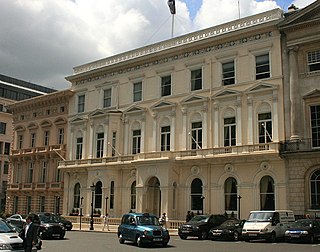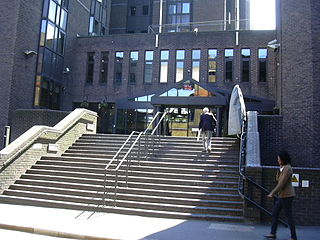
The New Cavendish Club was a London private members' club, run along the lines of a traditional gentlemen's club, although it had been founded as a Ladies-only club. It was located at 44-48 Great Cumberland Place in the Marylebone district.

The New Cavendish Club was a London private members' club, run along the lines of a traditional gentlemen's club, although it had been founded as a Ladies-only club. It was located at 44-48 Great Cumberland Place in the Marylebone district.
It was founded in 1920 by Margaret Russell, Lady Ampthill in her capacity as Chairman of the Voluntary Aid Detachment of nurses during World War I, and was intended to be "a first class Ladies' Club" for veteran nurses of the VAD.
The club opened with its inaugural dinner on 14 June 1920, with a 999-year lease acquired on premises at Queen Anne House, 28 Cavendish Square. The building was formerly Marshall Thomson's Hotel, which is described in William Makepeace Thackeray's Vanity Fair . The club's dining room was originally staffed by VAD veterans from the war. The Cavendish Square building was damaged by a fire bomb during the Blitz.
In 1957, the club sold its clubhouse, and moved in 1959 to its new premises in Great Cumberland Place, which required extensive modernisation - bomb damage from the war meant that the interior had to be almost entirely rebuilt from scratch. Between vacating the old building in September 1958 and moving to the new one in December 1959, the club's members were welcomed at several other London clubs on a temporary basis.
After the move, membership was then offered to members of the defunct Cowdray Club and Guide Club, as well as women of the Magistrates Association and the Women's Voluntary Service. Men were also finally admitted.
The club closed in 2014 and, after period of negotiation, the remaining members were invited to join the Naval and Military Club. The Clubhouse was sold to Home House private members' club and is being re-launched as "Home Grown" - a private members' business club.

The Carlton Club is a private members' club in the St James's area of London, United Kingdom. It was the original home of the Conservative Party before the creation of Conservative Central Office. Membership of the club is by nomination and election only.

The East India Club is a gentlemen's club founded in 1849 and situated at 16, St James's Square in London. The full title of the club is East India, Devonshire, Sports and Public Schools' Club due to mergers with other clubs. The club was originally founded for officers of the East India Company, and its first Patron was Prince Albert.

Chelsea Arts Club is a private members' club at 143 Old Church Street in Chelsea, London with a membership of over 3,800, including artists, sculptors, architects, writers, designers, actors, musicians, photographers, and filmmakers. The club was established on 21 March 1891, as a rival to the older Arts Club in Mayfair, on the instigation of the artist James Abbott McNeill Whistler, who had been a member of the older club.
The Royal Commonwealth Society (RCS) is a non-governmental organisation with a mission to promote the value of the Commonwealth and the values upon which it is based. The Society upholds the values of the Commonwealth Charter, promoting conflict resolution, peace-making and democracy to improve the lives of citizens across the member states of the Commonwealth.

The Devonshire Club was a London gentlemen's club which was established in 1874 and was disbanded in 1976. Throughout its existence it was based at 50 St James's Street. The major Liberal club of the day was the Reform Club, but in the wake of the 1868 Reform Act's extension of the franchise, the waiting list for membership from the larger electorate grew to such an extent that a new club was formed to accommodate these new Liberal voters. The clubhouse was on the western side of St James's Street. The original intention was to call it the 'Junior Reform Club', along the model of the Junior Carlton Club formed in 1866, but complaints from the Reform Club's members led it to being named the Devonshire, in honour of its first chairman, the Duke of Devonshire, an aristocrat from a long line of Liberals.

Margaret Russell, Baroness Ampthill, was an English courtier and Red Cross volunteer, known for her long friendship with Queen Mary.

Arthur Oliver Villiers Russell, 2nd Baron Ampthill, was a British peer and civil servant. He served as Governor of Madras from October 1900 to February 1906, and as acting Viceroy of India from April to December 1904.

The Naval and Military Club, known informally as The In & Out, is a private members' club located in St James's Square, London. It was founded in 1862 for officers of the Navy and Army. It now also accepts female members, and members who have not served in the armed forces, but continues to observe service traditions.

The Union Jack Club is an Armed Forces Club in central London, England, for enlisted members and veterans of the British Armed Services and their families. Located near London Waterloo railway station, the club has over 260 rooms for accommodation, restaurant, bar, small library, and a full range of meeting and banqueting rooms.

The Caledonian Club is a prestigious Scottish-focused London members' club located at 9 Halkin Street SW1, near Belgrave Square in Belgravia, London, SW1.

The Voluntary Aid Detachment (VAD) was a voluntary unit of civilians providing nursing care for military personnel in the United Kingdom and various other countries in the British Empire. The most important periods of operation for these units were during World War I and World War II. Although VADs were intimately bound up in the war effort, they were not military nurses, as they were not under the control of the military, unlike the Queen Alexandra's Royal Army Nursing Corps, the Princess Mary's Royal Air Force Nursing Service, and the Queen Alexandra's Royal Naval Nursing Service. The VAD nurses worked in field hospitals, i.e., close to the battlefield, and in longer-term places of recuperation back in Britain.

The Oxford and Cambridge Club is a traditional London club. Membership is largely restricted to those who are members of the universities of Oxford and Cambridge, including men and women who have a degree from or who are current students of either university.

Dover Street is a street in Mayfair, London. The street is notable for its Georgian architecture as well as the location of historic London clubs and hotels, which have been frequented by world leaders and historic figures in the arts. It also hosts a number of contemporary art galleries. An equestrian sculpture by Elisabeth Frink stands on the junction of Dover Street and Piccadilly, opposite the Ritz Hotel.

Albert Ernest Kitson, 2nd Baron Airedale was a British peer. He was inter alia a director of Midland Bank.
The Unionist Club was a short-lived London gentlemen's club, now dissolved, which was established in 1886, and had wound up by 1892. For the last four years of its existence, it had a clubhouse at 66-68 Pall Mall.
Arthur's was a London gentlemen's club, now dissolved, which was established in 1811 and was disbanded in 1940. Between 1827 and 1940 it was based at 69 St James's Street. It is now best remembered for having built the London clubhouse currently occupied by the Carlton Club.

The Burlington Fine Arts Club was a London gentlemen's club based at 17 Savile Row.

The Cavalry and Guards Club is a London gentlemen's club, at 127 Piccadilly, situated next to the RAF Club.

Brooks's is a gentlemen's club in St James's Street, London. It is one of the oldest and most exclusive gentlemen's clubs in the world.

Our Lady of Victories, in Kensington, London, is a Roman Catholic church. The original church opened in 1869, and for 34 years to 1903 served as pro-cathedral of the Archdiocese of Westminster. That building was destroyed by bombing in 1940: its successor, which survives, opened in 1959. The church stands at 235a Kensington High Street, Kensington, in the Royal Borough of Kensington and Chelsea.